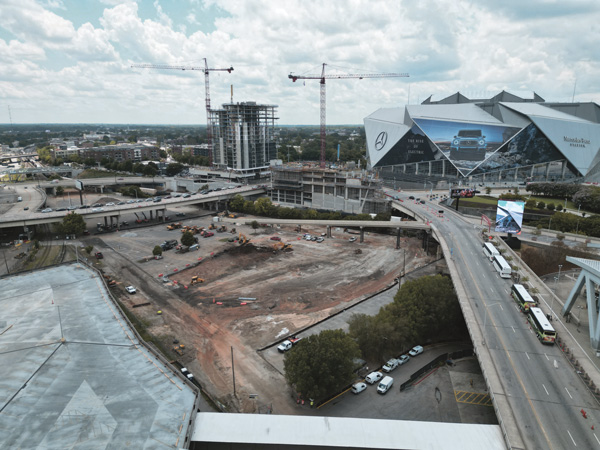In a world overflowing with fake downtowns, the real thing can be refreshing.
Unless, of course, it’s got a big hole in its heart.
That’s how former Atlanta mayor Andrew Young once described the area known as the Gulch, an underdeveloped patch of tangled infrastructure surrounded by parking, overpasses and attractions such as State Farm Arena (where the NBA’s Atlanta Hawks play), Mercedes-Benz Stadium, the massive Georgia World Congress Center and, just a few steps away, Atlanta University Center, home to HBCU institutions Morehouse College and the Morehouse School of Medicine, Clark Atlanta University and Spelman College.
Various schemes to redevelop the area always ran into roadblocks, until Tony Ressler came to town. In 2015, a group led by Ressler purchased the Atlanta Hawks. When he saw the Gulch up close, he immediately placed a call to his brother Richard, one of the founders of Los Angeles–based developer CIM Group, asking him to check it out.
The seed was planted, then cultivated in 2017 when the Georgia Legislature passed HB342, which provides for enterprise zone fees to be charged in lieu of sales tax. An entity called Centennial Yards Company was created. It acquired buildings in a roughly 50-acre footprint and by 2018 had commenced redevelopment of the area into a mixed-use district.
A few years on, serial entrepreneur and Georgia Tech graduate KP Reddy, founder and CEO of seed-stage tech investment firm Shadow Ventures, was in a meeting with CIM Group leaders and heard questions only an economic developer could answer. Asked who he might recommend, he referred them to Brian McGowan, who had left a post as president and CEO of Atlanta Beltline to become CEO of Greater Seattle Partners three years earlier. His resume also includes positions as U.S. Deputy Assistant Secretary of Commerce, Deputy Secretary of Commerce for the State of California, CEO of Invest Atlanta and Executive Vice President/COO of the Metro Atlanta Chamber.

 Construction is full steam ahead as Centennial Yards aims to welcome soccer fans during the 2026 World Cup, which will feature eight matches in Atlanta’s Mercedes-Benz Stadium.
Construction is full steam ahead as Centennial Yards aims to welcome soccer fans during the 2026 World Cup, which will feature eight matches in Atlanta’s Mercedes-Benz Stadium.
Rendering and photo courtesy of Gensler, Cosm and Centennial Yards
In a conversation between visits from various delegations in Centennial Yards Company’s offices overlooking the $5 billion redevelopment, McGowan says after lengthy phone calls and meetings with CIM Group executives about filling that “hole in the heart of a major American city,” he was told they were looking for a president to lead the effort. “I hesitated,” he says, “before saying, ‘I can probably find someone to help you do that.’ Then they said, ‘Would you be interested?’ And I said, ‘Oh, hell yes.”
He says the position “felt like I could apply all the skills, knowledge and things I’ve ever done as an economic developer as a capstone in my life. It’s business attraction, it’s incentives, it’s government relations, workforce development, affordable housing.” After a decision to self-perform instead of hiring a general contractor, he says, it’s also construction. And there’s a big deadline: The 2026 World Cup in the United States. As reported online by Site Selection intern David Owens earlier this summer, soccer in metro Atlanta is taking off, with the recent location of U.S. Soccer Federation’s HQ and national training center south of the city in Fayette County and the scheduled playing of no fewer than eight matches (including a semifinal) during the World Cup.
“We are full steam ahead, looking at that World Cup deadline as a really important marker,” McGowan says, when the project will be advanced enough to host large gatherings of fans to watch match broadcasts. Meanwhile, like the historic railyard nexus it occupies, Centennial Yards is catalyzing other real estate development activity spinning off its axis. The owner of Atlanta Tech Village, David Cummings, has just purchased a portfolio of 50 historic buildings in south downtown. CNN Center has come under new ownership. “I think all of this was inspired by CIM making such a huge commitment,” McGowan says. “This is having that ripple effect, causing other investors to see the potential of downtown Atlanta.”
How It Got Rolling
Though the entire site is designated as a brownfield, McGowan says the project has been surprisingly free of issues thus far and Norfolk Southern, which owned part of the property, has been easy to work with — perhaps in part because the project’s purchase of the railroad’s original HQ and property helped them make the decision fiscally to build their new HQ in Atlanta, McGowan suggests.
“You would think a former railyard would have lots of contamination issues, but we haven’t found any show-stoppers,” he says.
Asked what’s allowed the project to avoid a financial roadblock, he harkens back to his experience in California when redevelopment agencies were eliminated because affluent places like Indian Wells were allowed to claim the desert as blight and give their 20% set-asides for affordable housing to another city 20 miles away. “That caused legislators to eliminate it,” he says.
In Atlanta, there was a clear and bipartisan recognition that a 50-acre hole in the signature city of a region of 6 million people wasn’t good for anybody. “It disconnects downtown, makes it unwalkable. People are coming from all over the world, blimps are coming in and looking down and our major feature was a giant parking lot. There was unanimous agreement that not only was that an eyesore, but it was preventing good things from happening,” i.e. no workforce, no jobs, no revenue — essentially blighted property. “The only way you could make something happen was through incentives. So the state created an incentive, an enterprise zone, where a portion of the sales tax comes to Centennial Yards for 28 years. Then there’s a property tax incentive, a tax increment financing district where a portion of the property tax comes back to Centennial Yards. Those two are capped at $1.8 billion. We don’t see ourselves ever approaching that number.”
“I find Atlanta to be the most interesting of all the places I’ve lived. Atlanta is such an aspirational place. It wants to be bigger and better.”
— Brian McGowan, President, Centennial Yards Company
A misconception, he says, is that “people thought the city and state wrote us a check for $1.8 billion. But if you don’t create the value, you don’t get the value. Then you can capture a portion of that.” At the end of the time period, all tax revenue goes back to the city, county and school district. “Politicians had to make the decision,” McGowan says, knowing that if it was left the way it was, it would never generate value for anyone. “Even when I was CEO of the Beltline, with these TADs [tax allocation districts, Georgia’s version of TIF], it’s sometimes very difficult to explain how it works to the general public. People think it’s a give-away, but if incentives are used correctly, they fill the gap between a private-sector developer wanting to do something or not.”
Asked if the project has connected with any federal funding streams, McGowan says, “We have been talking to our congressional delegation, city and state leaders about opportunities that could make the project better if we get some kind of federal incentives. We’re going to build this no matter what, but there are things we could add to make it better for the public in the long run — transit, bike lanes, capping rail lines. That would require some kind of federal grant to make something like that happen.”
The timing of Centennial Yards is right for more reasons than just the World Cup. Even as 17 million people a year come to downtown Atlanta for events and venues such as the Georgia Aquarium, the National Center for Civil and Human Rights and various other venues and occasions, highway interchanges bringing those people downtown were designed and built in the 1960s and ’70s, and as a recent water main failure demonstrated, other infrastructure needs upgrading too. “There needs to be a more concerted effort on behalf of everyone together to go after federal dollars to improve the infrastructure of downtown,” McGowan says. One day there may even be a way to connect to the universally praised Atlanta Beltline trail system, which eventually is envisioned to connect to a larger metro region trail system extending into the suburbs.
But downtown Atlanta is the bull’s-eye, making this mixed-use redevelopment different from other successful districts, including The Battery near the Atlanta Braves’ Truist Park in Cobb County. There are four MARTA rail transit stations surrounding Centennial Yards, three sports teams playing at neighboring venues and a convention center. “A lot of these sports-adjacent districts around the country have some of those, but not all of those,” McGowan says. Nor do they have plans for 8 million sq. ft. of development, including office and 3,000 apartments.
Better physical connections to Atlanta University Center are part of the plan too.
“Atlanta University Center students already are living in one of our buildings,” McGowan says. “More students and professors and staff will live there. One of the things that excites me the most about this site is its proximity between three major university campuses — Georgia Tech, Georgia State University and Atlanta University Center. Think about serendipitous interactions around places like Tech Square,” the mixed-use environment at Georgia Tech’s campus. “There are over 100,000 students within a scooter’s ride or walking distance. There are lots of opportunities for incubators and accelerators. I think corporate innovation centers will want to be here to attract that talent to work for their companies.”

